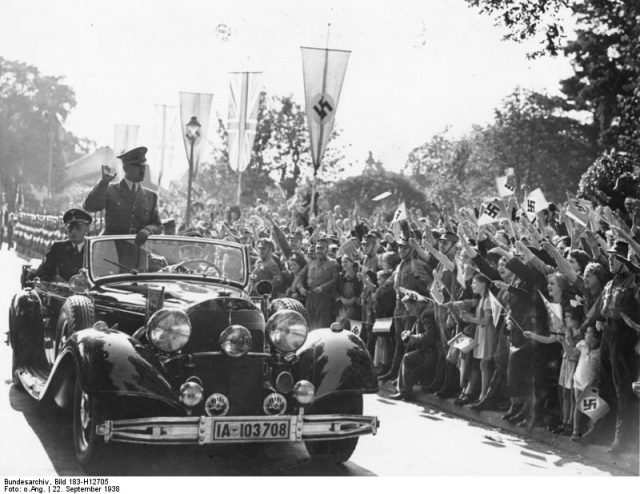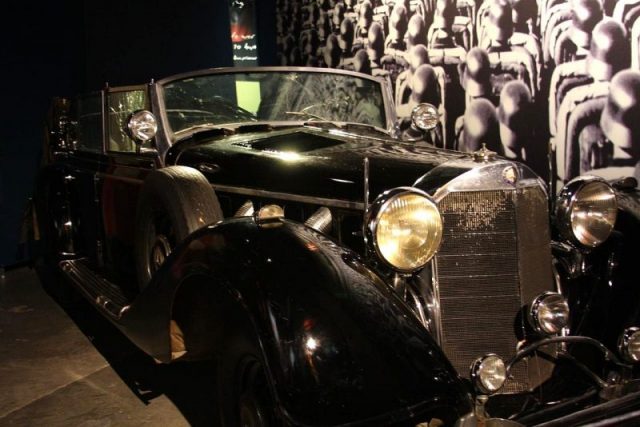Dubbed the “Super Mercedes,” this rare vehicle, which reportedly conveyed the infamous Nazi dictator to victory parades and other appearances in Germany and which was offered at an auction by Worldwide Auctioneers in Scottsdale, Arizona, failed to reach its minimum sale price on January 17, 2018.
The highest bid hit $7 million, but that did not surpass the reserve price, an amount set by the anonymous seller of the Nazi artifact that was not revealed to the public. Some surmise that the automobile was expected to fetch double the recent highest bid solely for its engineering and design.
The automobile, a Mercedes-Benz 770K Grosser Offener Tourenwagen, was reportedly delivered to Hitler in 1939 and is said to be one of just five, with three out of the five being in private ownership. The auction house reports that the rare vehicle was claimed by the U.S. Army at the war’s end in 1945, and since then it has changed ownership several times. Options for its sale are still open as it has been announced that talks with the highest bidder are set to continue in private, representatives of Worldwide Auctioneers stated.
The hope is that the new owner would use Hitler’s Mercedes in an educational context. Lawrence Bell from the Arizona Jewish Historical Society, while retaining a neutral stance on Nazi memorabilia circulating in the hands of private collectors, says, “There’s a huge interest and market for Nazi paraphernalia which, whether people are happy about that or not, doesn’t really matter.” He added that ideally such artifacts belong in museums or used for “educational purposes.”

The bidding for Hitler’s Super Mercedes required interested parties to register for the process and undergo an interview. A goal to use the vehicle to educate was reportedly one of the set requirements to qualify as a bidder. However, the eventual new owner would retain the freedom of how the car can be used or stored in the end.
“We’re very aware of where the car would be best suited” were the words of Ron Egan, one of the Worldwide Auctioneers co-founders. Earlier in January, before the auction, Egan expressed a belief that real enthusiasts would rather praise the automobile for being a genuine model, instead of value it because of who used it during the war. “Museum settings, stuff like that. And major collections and people that will exhibit the car and use it as an educational tour,” said Egan.
Ahead of the auction, the 770K model was dubbed “the most historically significant automobile ever offered for public sale,” yet even with such a designation, it has failed to reach the minimum set amount. For auctioneers, who said that the vehicle remains to be “quite likely the world’s greatest achievement in terms of automotive design, engineering, and construction,” expectations were that it could fetch up to $14 million.
The engine of the model is capable of speeds up to 100 mph, and the automobile has a bulletproof windshield and protective armor plating. Hitler used it in the period between 1939 and 1941, after the model had been commissioned at the request of Erich Kempka, his Number One chauffeur from 1934 up until the very end. Kempka is remembered as one of the persons responsible for the burning of the corpses of Hitler and Eva Braun after their suicide on April 30, 1945.
The splendid model was delivered to Hitler in Berlin on July 29, 1939. For the Führer and his distinguished guests, the vehicle would provide not only maximum protection but also a display of luxury and prestige. The first outing of the Super Mercedes took place in early October that year, when it joined a crowded motorcade in which Hitler was brought to the Old Reich Chancellery. It was a motorcade widely followed by both domestic and international journalists.

The vehicle reportedly carried Hitler during victory parades after capturing territories such as France, Greece, and Yugoslavia, and it was used in Munich for an official visit by Hitler’s Italian colleague, Benito Mussolini, in June 1940, the Mail Online has reported.
After the war, the U.S. military police forces in France used the vehicle, and after a time it was sent to the United States, where the vehicle appeared in several military parades. Nothing significant happened with the car in the next couple of decades, until 1976, when the model was restored and exhibited in a museum in Chicago. After that, the Mercedes changed ownership a couple of times, the last time reportedly being in 2009, when it came into the hands of a Russian private collector.
When the car sells, 10 percent of the sale price is expected to be donated to the Simon Wiesenthal Center, a Jewish human rights organization headquartered in Los Angeles, and which carries the name of a distinguished Nazi hunter and survivor of the Nazi death camps.
